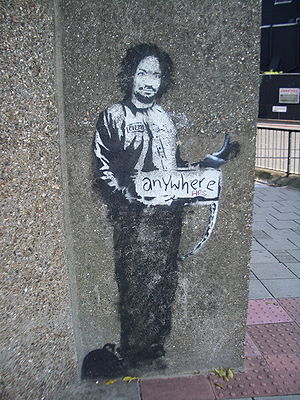Banksy, perhaps one of the most infamous artists of the early 21st century, has brought attention to guerilla art giving rise to a love affair with everything street in some of the world’s premier art institutions.
Recognised and documented all over the world, Banksy’s work has become part of urban popular culture. Often taking the form of satire, his stencil art seeks to comment and reflect society, usually in relation to the location that it has been created in. Banksy’s work is politics with a sense of humour, an anti-elitist, anti-establishment commentary, that, as a byproduct has opened the somewhat closed and clandestine art industry to the ordinary every day dwellers of the cities that these works reside in.
The legality of what Banksy does seems to have been dismissed by most. His works could be considered as criminal damage by property owners and the municipal bodies but are tolerated because of the notoriety and acclaim that they can bring to the respective areas. It seems that Banksy has created a moral dilemma for the authorities. What constitutes the difference between vandalism and street art? Ironically, his cultural success has encouraged authorities to endorse the art form and designate spots such as Leake Street at Waterloo station in London as an acceptable place to commit paint to brick.
The “Cans Festival”, imagined and contributed to by Banksy has become a regular event and with its private and public endorsement has somewhat killed the “edgy” side of street art. Banksy’s style has been compared to Blek le Rat (otherwise known as Xavier Prou) who is seen by some as the godfather of guerilla art. The style of both Blek le Rat and Banksy is a product of the need for the work to be completed in great haste, avoiding detection and possible legal repercussions. Mostly in black and white with the odd accent in colour, the stencils are sometimes accompanied with text and vary greatly in scale and quality. This has led to many believing that the work is completed by many individuals rather than a single artist.
Some consider Banksy stencils to be intelligent, altruistic and activist whilst others view them as cheap, one-liners where the punch line whilst witty, is brief and the importance of the messages lost in aesthetic analysis. With Banksy, one question keeps cropping up. Is the work created to highlight the issues it represents or are the issues highlighted simply as the product of the use of faddish and populist ideas to validate its own existence?
The varied and wide ranging issues that his works have covered include commentary on the Palestinian and Israeli conflicts, homelessness, elitism, consumerism, xenophobia, political corruption, the economy, crime… The list continues.
Is Banksy shallow or is there passion in the meaning? It could be said that it doesn’t matter either way if the issues themselves are given attention that would not have otherwise existed. Either way, even if his motives are doubtful, his success and the fact that he is now embedded into our urban histories cannot be disputed.


I thought banksy was a collective – no one knowing the guy due to there not being one flaccid entity known as… still; worthy stencil art to run in tandem with the consumer ephemeral tendencies of nowadays society… failing all this – I have just missed a live Euro championships match on BBC2!
Nice theory!
Nope, Banksy very much is a singular being – there are others like the wooster collective etc that claim to be a nebulous entity but Banksy very much works within the confines of his own creativity – his identity is not quite as unknown as it was, still not 100% certain but most people have some idea!